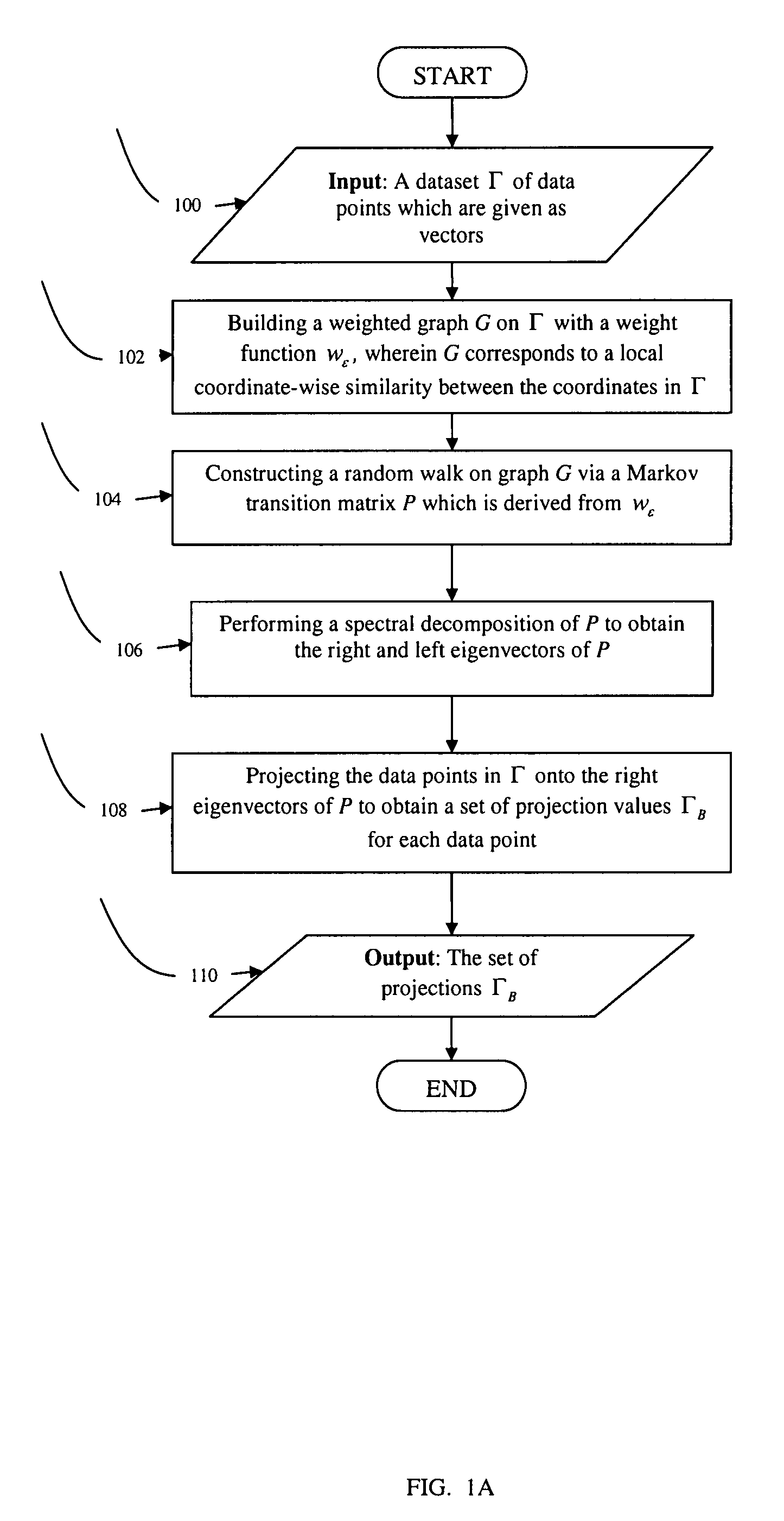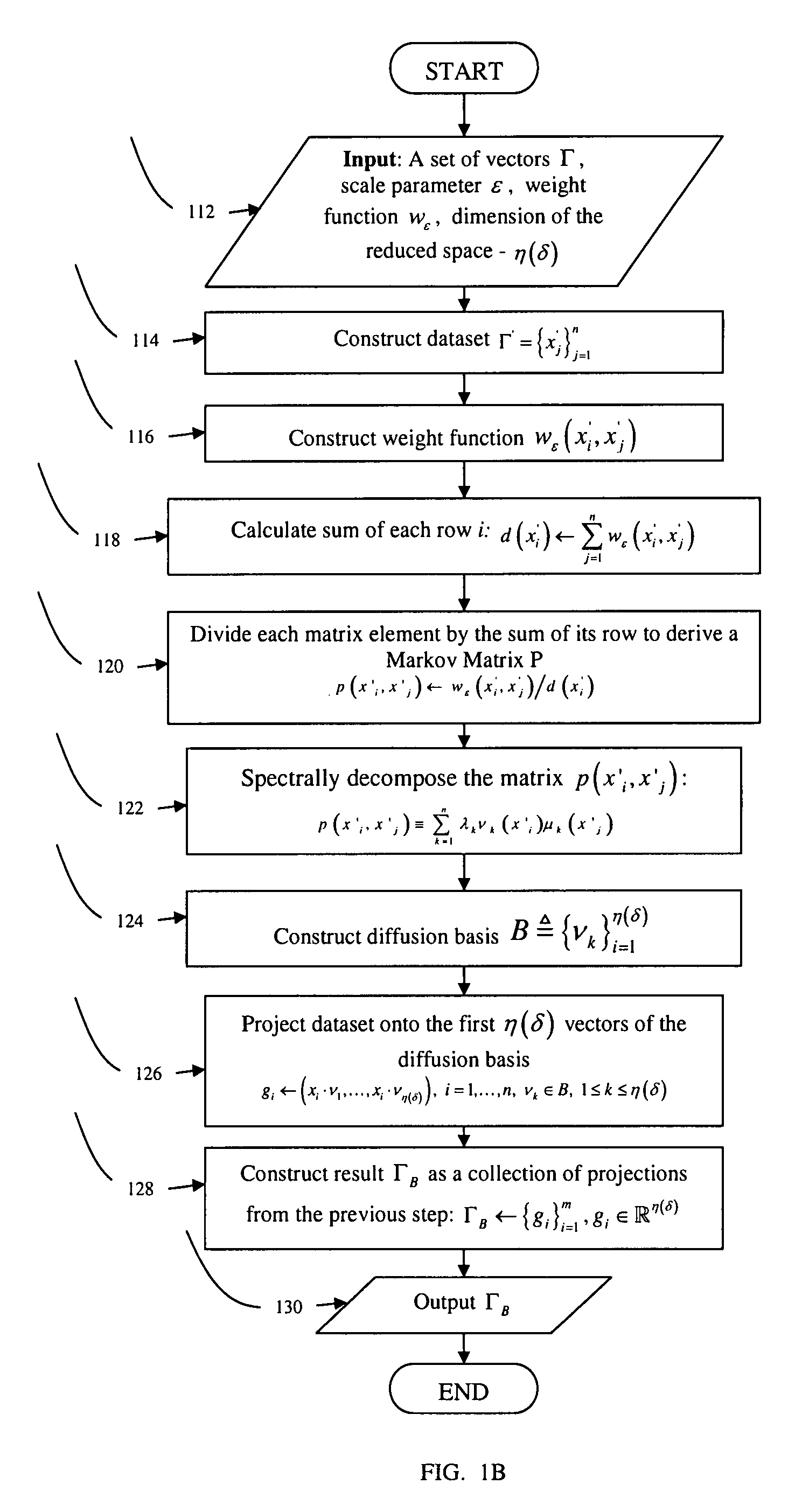Diffusion bases methods for segmentation and clustering
a clustering and diffusion base technology, applied in the field of image processing algorithms, can solve the problems methods that fail to produce satisfactory segmentation, and none of the segmentation/clustering methods described above are intended for segmentation/clustering of hyper-spectral data volumes. , to achieve the effect of reducing the dimensionality of data
- Summary
- Abstract
- Description
- Claims
- Application Information
AI Technical Summary
Benefits of technology
Problems solved by technology
Method used
Image
Examples
first embodiment
[0075]FIG. 1a shows the main steps of the DB algorithm. A dataset Γ of data points which are given as vectors is provided in step 100. A graph G is then built on Γ with a weight function wε in step 102. The weight function corresponds to the local coordinate-wise similarity between the coordinates in Γ. A random walk is constructed on graph G via a Markov transition matrix P which is derived from wε in step 104. A spectral decomposition of P is performed in step 106, and the data points in Γ are projected onto the eigenvectors of P in step 108. The set of projections ΓB is then output in step 110.
[0076]FIG. 1b provides more details of the steps in FIG. 1a. The dataset Γ, the scale parameter ε, the weight function wε and the dimension of the reduced space η(δ) are input in step 112 to the DB algorithm. Let Γ={xi}i=1m,xiεn be the original dataset of vectors in n and let xi(j) denote the jth coordinate of xi, 1≦j≦n. The vector xj′(x1(j), . . . , xm(j)) is defined to be the jth coordina...
second embodiment
[0083]FIG. 2a shows the main steps of the DB algorithm according to the present invention. This is a “modified” DB algorithm with steps similar to that in FIG. 1a (i.e. steps 200, 202 match steps 100, 102 therein) except for the third step (204). The main difference vs. algorithm of FIG. 1a is that instead of constructing a Markov matrix P as in 104, step 204 constructs a matrix A which is the result of dividing each element of wε by the square sum of its row times the square sum of its column.
[0084]FIG. 2b describes in more detail the modified algorithm. Steps 212-218 are identical to steps 112-118. Dataset Γ, weight function wε, scale parameter ε and the dimension of the reduced space η(δ) are input to the modified algorithm in step 212. A dataset Γ′={xj′}j=1n is constructed in step 214. The weight function is calculated for Γ′ in step 216, as described in Eq. 1. Matrix A is then constructed in steps 218 and 220 following respectively Eqns. 3 and 8. A is spectrally decomposed acco...
PUM
| Property | Measurement | Unit |
|---|---|---|
| wavelengths | aaaaa | aaaaa |
| wavelengths | aaaaa | aaaaa |
| wavelengths | aaaaa | aaaaa |
Abstract
Description
Claims
Application Information
 Login to View More
Login to View More - R&D
- Intellectual Property
- Life Sciences
- Materials
- Tech Scout
- Unparalleled Data Quality
- Higher Quality Content
- 60% Fewer Hallucinations
Browse by: Latest US Patents, China's latest patents, Technical Efficacy Thesaurus, Application Domain, Technology Topic, Popular Technical Reports.
© 2025 PatSnap. All rights reserved.Legal|Privacy policy|Modern Slavery Act Transparency Statement|Sitemap|About US| Contact US: help@patsnap.com



